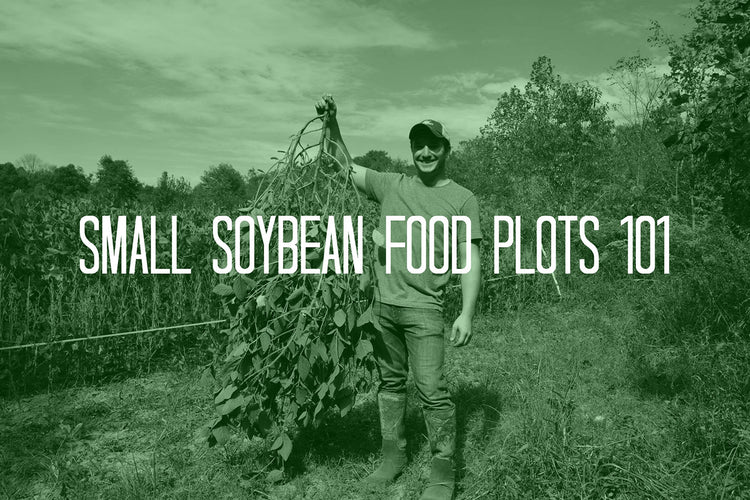Small Soybean Food Plots 101
Article and Video by: Weston Schrank From the author:
These are the videos and my notes on a project I ran 2 years ago. This is my experience with a 1-acre soybean food plot, start to finish with the DeerGro products, and even throughout the hunting season. Again, this was 2 years ago so be sure to read my after thoughts and comment with questions! This video will walk you through day 1 – hunting the plot.
Soybean food plots are the deer manager's and hunter's best friend no doubt about it. However, the one thing that limits soybeans is the size of the food plot. Make and Install your very own DIY dual perimeter electric fence to successfully grow a small soybean food plot! Soybean food plots are the deer manager's and hunter's best friend no doubt about it. They can be not only key summer nutrition, but one of the best early-season bow hunting attractants, and a sustaining late-season food source. The one thing that limits soybeans is the size of the food plot. A general rule of thumb without knowing deer density is that 3-5 acres are the minimum acreage you need. Any less and you will have stubble growing as the deer simply mow it down before it can catch up with browse. This leaves you with two options, you either plant something else or protect your food plot till hunting season.
A dual perimeter electric fence is by far the cheapest, easiest, and most effective way to keep deer out of the soybean food plot. It gives you the chance to not only protect your beans to early season or late season whatever you prefer but also channel the deer into one side of the plot. However, they can put a dent in your wallet, most kits available online are anywhere from 450- 1000 dollars depending on your size and preferences. If you’re like me and like to find the best solution, you can easily gather the materials from local hardware and farm supply stores and end up with the same product for less. Using a dual perimeter electric fence should keep deer out for however long it is up and holding a charge, you can either take it down for summer nutrition once the beans take off, wait for archery season just before the acorns drop, or wait till the late season to have a good stand of beans to hunt in the snow over. You can also decide to take down a section of the fence, allowing you to funnel deer closer into the soybean food plot closer to your stand. If you’re desperately wanting beans, and know it could mean success for you this fall, set up a dual perimeter electric fence. It will last years and could mean success time and time again.
| 10 Mile Solar Energizer | 180.00 |
| ½ inch poly tape 1312’ | 50.00 |
| 2 poly wire 1312’ | 60.00 |
| Ground Rod | 15.00 |
| Ground rod clamp | 2.50 |
| Energizer-to-tape clamp | 2.00 |
| 100ft of 17g Galvanized wire | 3.00 |
| 50 step-in posts (white) | 75.00 |
| 6ft t-post | 3.50 |
| Sub Total | 391.00 |
| Total | 418.37 after tax – (covers ¾ acre) |
Electric Fence and Soybean Food Plot Maintenance
The second part of this soybean food plot series occurs just after I check the soybeans midway through the growing season. Once a food plot protective fence goes down, the gig is up. But there are still some options to keep whitetails out of the food plot.
The dual perimeter electric fence protecting the small soybean plot has been effective for the majority of the summer but has run into some problems. Over the holiday weekend, a doe or buck got tangled in the fence and dropped a section between posts. Just one instance of this, when the electricity is gone or has little left can ruin this setup. Once the fence loses the visual 3D effect and the power to scare the deer away they figure out they can jump right over it. After this, the gig is up, and there is not much you can do. And the way I figure it I have three options.
Option one I simply take the fence down, and hope for more success next year. The benefits of this are the deer here are going to have more access to protein for the remaining summer. It also gives me a chance to scout and film velvet bucks. When August comes, I will broadcast forage rape and oats over the beans, giving me something to hunt over during deer season.
Option two, I raise the wires up a notch or two, ensure it’s not grounded by weeds, and check it often to keep it effective until at least bow season. In this case, I would also broadcast my fall mix over the beans around August, ensuring I have more food there all of the deer season.
Option three is a combination, I’ll again try and get the fence to work, but prepare for the worst. My plan is to come through and plant another 30-40 lbs. of beans per acre. This will give these beans a head start in the incident that deer keep coming in the plot. This will hopefully extend the life of the beans out another month. Again in August, I will come through and plant my fall food plot. In any case, I’m going to put up a camera, see when the deer are coming in and out of the plot, and see if I can’t pattern a mature buck early this season, and get some velvet footage.
Opening the Fence on the Soybean Food Plot
Part three in the video series takes place on the 27th of September, three days out from the archery opener on the 1st of October and we are taking the fence down on the beans! We had this up since we planted these beans in May and it’s done a terrific job at keeping them protected. We let this fence down today for a couple of reasons, the first and most obvious is it’s a week before the season starts so it’ll give the deer time to adjust, the second is commercial and neighboring crop fields, the beans are yellow and the corn was just recently combined causing deer to finally switch from their summer home range to their fall core areas giving rise to our third and final reason the return of our bucks on trial camera. Two days ago Oscar a 3 yr. old this year returned on the property and he’s a nice buck, we're going to entice him to stay with this buffet, and hopefully, develop a pattern with him shortly for October or November.
Now you might be wondering how these beans are one this tall and two still green, and its because we planted Eagle Seed Forage Soybeans specifically Big Fellow roundup-ready beans and have a longer life cycle than commercial beans, meaning more tonnage of growth past the reaches of the combine and green leaves well into October, making a bow hunter’s dream for early, mid and late season.
After Thoughts and Hunting Strategies
Now considering how the 1-acre soybean food plot ended up, I wish I would have gone with a little bit different setup. One, I might have had better luck going with a conventional bean that would mature earlier with more bean pods rather than early forage production. This would create the ability to spread a fall food plot such as cereal rye and brassicas under the beans as they turned in September. The early maturing conventional beans would have put on far more pods, and I would have afforded the ability to put twice as much food on the table with a fall food plot planting!
Another key point that I would like to dive into is pressure. This plot was simply overpressured. As you can see I was down at this plot often, without equipment running which is a definite NO NO. The pressure was overwhelming for the deer herd and as a result, just a couple of does were actually feeding in the plot on a regular basis. Running a four-wheeler and not visiting the plot so much, especially filming as I did would have most likely ended in a far better result! Just my last thoughts on the subject…This is a worthwhile investment, just be sure to logically think your food plot strategy through! I invite you to click the link below and walk through my food plot program suggestions!


